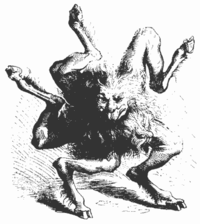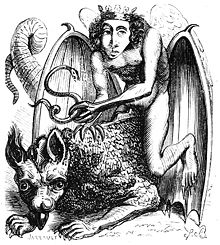The
Lesser Key of Solomon, also known as the
Clavicula Salomonis Regis[note 1] or
Lemegeton, is an
anonymous grimoire (or spell book) on
demonology. It was compiled in the mid-17th century, mostly from materials a couple of centuries older.
[1][2] It is divided into five books—the
Ars Goetia,
Ars Theurgia-Goetia,
Ars Paulina,
Ars Almadel, and
Ars Notoria.
[1][3]
Ars Goetia[edit]
The most obvious source for the
Ars Goetia is
Johann Weyer's
Pseudomonarchia Daemonum in his
De praestigiis daemonum. Weyer does not cite, and is unaware of, any other books in the Lemegeton, indicating that the Lemegeton was derived from his work, not the other way around.
[1][4] The order of the spirits was changed between the two, four additional spirits were added to the later work, and one spirit (
Pruflas) was omitted. The omission of Pruflas, a mistake that also occurs in an edition of
Pseudomonarchia Daemonum cited in
Reginald Scot's
The Discoverie of Witchcraft, indicates that the
Ars Goetia could not have been compiled before 1570. Indeed, it appears that the
Ars Goetia is more dependent upon Scot's translation of Weyer than Weyer's work in itself. Additionally, some material was used from
Heinrich Cornelius Agrippa's
Three Books of Occult Philosophy, the
Heptameron by pseudo-Pietro d'Abano,
[note 2][1][5] and
the Magical Calendar.
[6]
Weyer's
Officium Spirituum, which is likely related to a 1583 manuscript titled
The Office of Spirits,
[7] appears to have ultimately been an elaboration on a 15th-century manuscript titled
Le Livre des Esperitz (of which 30 of its 47 spirits are nearly identical to spirits in the Ars Goetia).
[2][5]
This portion of the work was later translated by S. L. MacGregor Mathers and published by
Aleister Crowley under the title
The Book of the Goetia of Solomon the King. Crowley added some additional invocations previously unrelated to the original work, as well as essays describing the rituals as psychological exploration instead of demon summoning.
[9]
The Seventy-Two Demons[edit]
The demons' names (given below) are taken from the
Ars Goetia, which differs in terms of number and ranking from the
Pseudomonarchia Daemonum of Weyer. As a result of multiple translations, there are multiple spellings for some of the names, which are given in the articles concerning them.
The demons are described as being commanded by four kings of the cardinal directions:
Amaymon (East),
Corson (West),
Ziminiar (North), and
Gaap (South). A footnote in one variant edition instead lists them as Oriens or Uriens, Paymon or Paymonia, Ariton or Egyn, and Amaymon or Amaimon, alternatively known as Samael, Azazel, Azael, and Mahazael (purportedly their preferred
rabbinic names).
[10] Agrippa's Occult Philosophy lists the kings of the cardinal directions as Urieus (East), Amaymon (South), Paymon (West), and Egin (North); again providing the alternate names Samuel (i.e. Samael), Azazel, Azael, and Mahazuel. The Magical Calendar lists them as Bael, Moymon, Poymon, and Egin,
[11][12] though Peterson notes that some variant editions instead list '"Asmodel in the East, Amaymon in the South, Paymon in the West, and Aegym in the North"; "Oriens, Paymon, Egyn, and Amaymon"; or "Amodeo [
sic] (king of the East), Paymon (king of the West), Egion (king of the North), and Maimon."'
[11]
Ars Theurgia Goetia[edit]
The
Ars Theurgia Goetia mostly derives from Trithemius's
Steganographia, though the seals and order for the spirits are different due to corrupted transmission via manuscript.
[5][13] Rituals not found in
Steganographia were added, in some ways conflicting with similar rituals found in the
Ars Goetia and
Ars Paulina. Most of the spirits summoned are tied to points on a compass, four Emperors tied to the cardinal points (
Carnesiel in the East,
Amenadiel in the West,
Demoriel in the North and
Caspiel in the South), sixteen Dukes tied to cardinal points, inter-cardinal points, additional directions between those. There are an additional eleven Wandering Princes, totaling thirty one spirit leaders who each rule several to a few dozen spirits.
[14]
Ars Paulina[edit]
Derived from book two of Trithemius's
Steganographia and from portions of the
Heptameron, but purportedly delivered by
Paul the Apostle instead of (as claimed by Trithemius)
Raziel. Elements from
The Magical Calendar, astrological seals by Robert Turner's 1656 translation of
Paracelsus's
Archidoxes of Magic, and repeated mentions of guns and the year 1641 indicate that this portion was written in the later half of the seventeenth century.
[15][16] Traditions of Paul communicating with heavenly powers are almost as old as
Christianity itself, as seen in some interpretations of
2 Corinthians 12:2-4 and the apocryphal
Apocalypse of Paul. The
Ars Paulina is in turn divided into two books, the first detailing twenty-four angels aligned with the twenty-four hours of the day, the second (derived more from the Heptameron) detailing the
360 spirits of the degrees of the zodiac.
[16]
Ars Almadel[edit]
Mentioned by Trithemius and Weyer, the latter of whom claimed an Arabic origin for the work. A 15th-century copy is attested to by Robert Turner, and Hebrew copies were discovered in the 20th century. The
Ars Almadel instructs the magician on how to create a wax tablet with specific designs intended to contact angels via
scrying.
[17][18]
Ars Notoria[edit]
The oldest known portion of the
Lemegeton, the
Ars Notoria (or
Notory Art) was first mentioned by Michael Scot in 1236 (and thus was written earlier). The
Ars Notoria contains a series of prayers (related to those in
The Sworn Book of Honorius) intended to grant
eidetic memory and instantaneous learning to the magician. Some copies and editions of the
Lemegeton omit this work entirely;
[19][20] A. E. Waite ignores it completely when describing the
Lemegeton.
[4] It is also known as the
Ars Nova.
Astaroth
From Wikipedia, the free encyclopedia
Background[edit]
The name
Astaroth was ultimately derived from that of
2nd millennium BC Phoenician goddess
Astarte,
[1] an equivalent of the Babylonian
Ishtar, and the earlier Sumerian
Inanna. She is mentioned in the
Hebrew Bible in the forms
Ashtoreth (singular) and
Ashtaroth (plural, in reference to multiple statues of her). This latter form was directly transliterated in the early Greek and Latin versions of the Bible, where it was less apparent that it had been a plural feminine in Hebrew.
The
pseudepigraphal work
Testament of Solomon, attributed to
King Solomon of Israel, but thought to date to the early centuries AD, mentions "Asteraoth" (in Greek) as an angel, who is opposed to the demon of power. (cf.
1 Kings 11:4-5).
Appearances in literature[edit]
The name "Astaroth" as a male demon is first known from
The Book of Abramelin, purportedly written in
Hebrew ca. 1458, and recurred in most
occult grimoires of the following centuries. Astaroth also features as an arch-demon associated with the
qliphoth (adverse forces) according to later
Kabbalistic texts.
Dutch demonologist
Johann Weyer also described Astaroth in his
Pseudomonarchia Daemonum (1577) thus:
Astaroth is a great and a strong duke, coming forth in the shape of a foul angel, sitting upon an infernal dragon, and carrying on his right hand a viper, who also claimed to rule 40 legions, and had to be approached by the conjurer with a magical ring on account of his stinking breath.
[2] He is similarly referred to in the 17th-century work
The Lesser Key of Solomon.

Astaroth's seal (according to
The Lesser Key of Solomon)
According to some
demonologists of the 16th century, August is the month during which this demon's attacks against man are stronger. According to
Sebastien Michaelis, he is a
demon of the First Hierarchy, who seduces by means of laziness, vanity, and rationalized philosophies. His adversary is St.
Bartholomew, who can protect against him for he has resisted Astaroth's temptations. To others, he teaches
mathematical sciences and handicrafts, can make men invisible and lead them to hidden treasures, and answers every question formulated to him. He was also said to give to mortal beings the power over serpents.
According to
Francis Barrett (c. 1801), Astaroth is the prince of accusers and inquisitors. In art, in the
Dictionnaire Infernal (1818), Astaroth is depicted as a nude man with feathered wings, wearing a crown, holding a
serpent in one hand, and riding a beast with
dragon-like wings and a serpent-like tail.
See also[edit]
References[edit]



